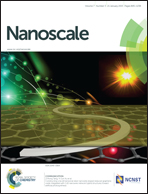A binary AxB1−x ionic alkaline pseudocapacitor system involving manganese, iron, cobalt, and nickel: formation of electroactive colloids via in situ electric field assisted coprecipitation†
Abstract
A new “combinatorial transition-metal cation pseudocapacitor” was demonstrated by designing combinatorial transition-metal cation pseudocapacitors with binary AxB1−x salt electrodes involving manganese, iron, cobalt, and nickel cations in an alkaline aqueous electrolyte. Binary multi-valence cations were crystallized in the colloidal state through an in situ coprecipitation under an electric field. These electroactive colloids absorbed by carbon black and the PVDF matrix are highly redox-reactive with high specific capacitance values, where the specific electrode configuration can create short ion diffusion paths to enable fast and reversible Faradaic reactions. This work shows huge promise for developing high-performance electrical energy storage systems via designing the colloidal state of electroactive cations. Multiple redox cations in the colloidal state can show high redox activities, making them more suitable for potential application in pseudocapacitor systems.


 Please wait while we load your content...
Please wait while we load your content...